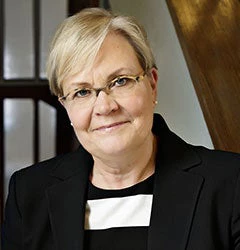
As we head into Spring Meetings in Washington, Sierra Leone is very much in my thoughts, because it is a country that faces many serious challenges—especially those relating to the survival of women and children—and because I’ve just returned from there, and have seen firsthand some of the efforts that are being made to turn this situation around.
This was an opportunity to look at human development in Sierra Leone through the lens of our new strategy in Africa, which was developed through extensive consultations. The strategy is built around two key themes: competitiveness and employment, and vulnerability and resilience; and its foundation is governance and public sector capacity. This is all so very relevant in Sierra Leone.
Having met with both policy makers and communities, I saw strong signs of the government's commitment to improving weak maternal and child health indicators—a part of what we see as vulnerability—through free health care for pregnant women and children. While aid flows to health are relatively generous and domestic revenues may rise, the country also has severe capacity constraints.
Given our increasing focus on fragile states, through our latest World Development Report and through IDA16, I think we have a major opportunity in Sierra Leone to help bring about rapid transformations in human development. We need to bring in more results-based financing into our operations here and also help the government to assess the impact of the free health care initiative.
I think that continuing to improve decentralized service delivery may be the best way to bridge the gaps in basic health and education in Sierra Leone. I saw the impact of our support to decentralization of service delivery during a trip to Moyamba District. My visit there began with an animated discussion at the local council office, including with councilors and decentralized staff. Moyamba is an opposition-led local council. I saw considerable progress and understood what can be achieved with dedicated staff and resources at the local level and with community participation—including improvement of the town of Moyamba’s water supply under our Decentralized Service Delivery Project. I also saw that a labor-intensive public works program, which has received World Bank support, was helping to address local development issues.
Much as I learned during my trip to Moyamba, the high point of my visit was a public forum at Fourah Bay College—the oldest university in sub-Saharan Africa, established in 1827. My guest lecture there, and the discussion that followed, highlighted the fact that without universities and other tertiary institutions, a country cannot build the capacity needed for teaching, health care, public administration, engineering and innovation. And as our strategy notes, building a skilled workforce is essential as a country considers potential areas of high economic growth.
I came away thinking that we should do strong analytic work on sustainable higher education financing in Sierra Leone. Also, we should consider supporting secondary and higher education and skills training, given the severe shortages of managerial and professional staff, teachers, and so on, that Sierra Leone faces.
Africa today is a “young” continent with youth dominating the population in many countries. For this to translate into a demographic dividend—of higher savings, investments, and economic growth, as fertility declines and the working age population becomes relatively larger—investments in young people are key. The faces of women and children in Moyamba and students at Fourah Bay are frequent reminders to me this week of the urgent need to invest well in human development.


Join the Conversation